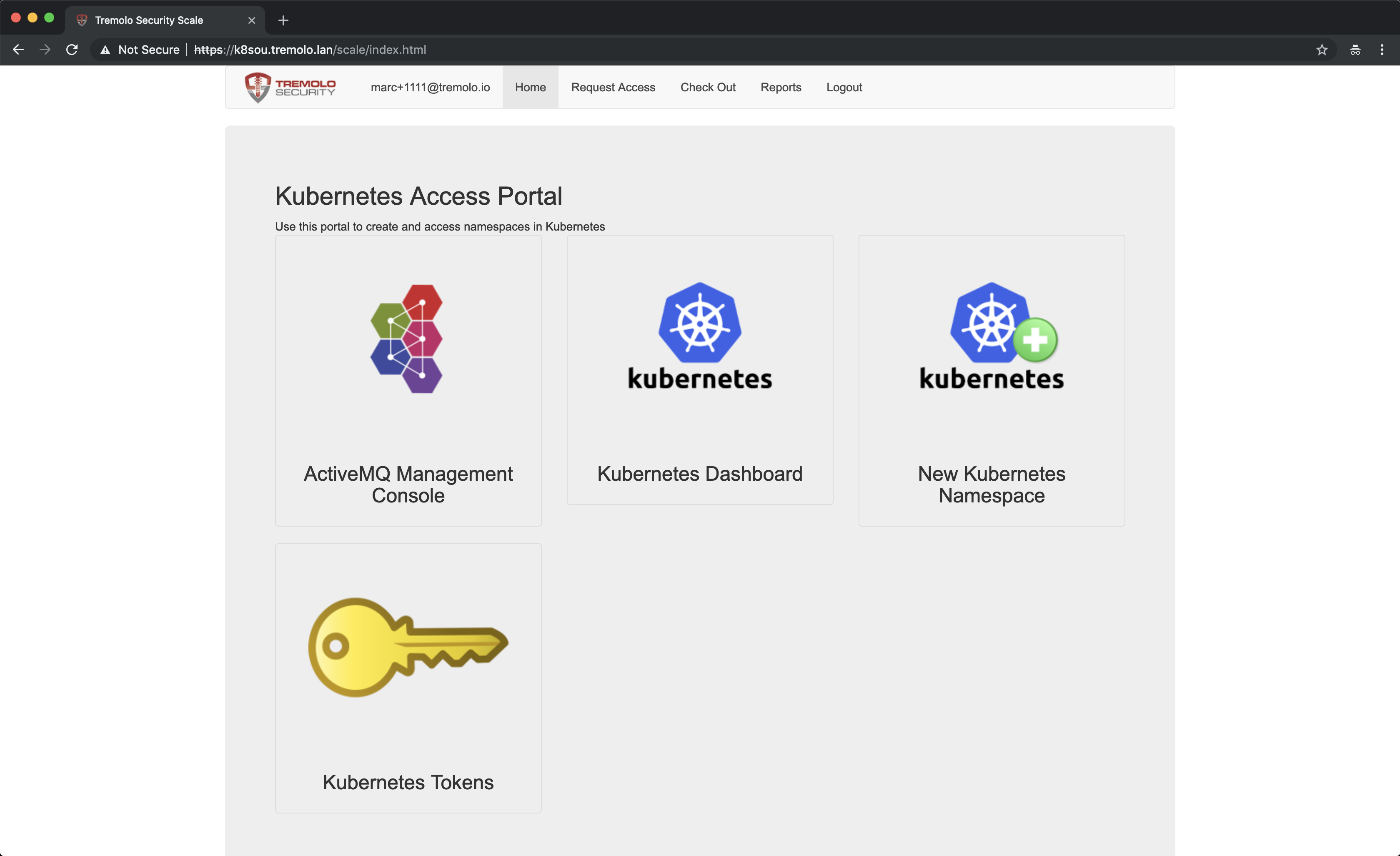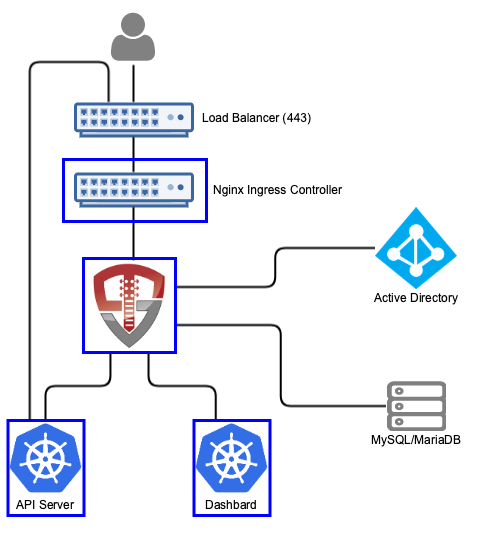Orchestra For Kubernetes - Active Directory and LDAP
Orchestra is an automation portal for Kubernetes built on OpenUnison. Orchestra integrates a user's identity into Kubernetes enabling:
- SSO between the API server and your LDAP infrastructure
- SSO with the Kubernetes Dashboard
- Self service access to existing Namespaces
- Self service creation of new Namespaces
- Workflows for automating access approvals without getting system administrators involved
- Built in self service reporting
When a user accesses Kubernetes using Orchestra, they'll access both the self service portal and the dashboard through OpenUnison's reverse proxy (instead of directly via an ingress). OpenUnison will inject the user's identity into each request, allowing the dashboard to act on their behalf.
Orchestra stores all Kubernetes access information as a groups inside of a relational database, as opposed to a group in an external directory. OpenUnison will create the appropriate Roles and RoleBindings to allow for the access.
Roles Supported
Cluster
- Administration - Full cluster management access
Namespace
- Administrators - All operations inside of a namespace
- Viewers - Can view contents of a namespace (except
Secrets), but can not make changes
Non-Kubernetes
- System Approver - Able to approve access to roles specific to OpenUnison
- Auditor - Able to view audit reports, but not request projects or approve access
Deployment
What You Need To Start
Prior to deploying OpenUnison you will need:
- Kubernetes 1.10 or higher
- The Nginx Ingress Controler deployed (https://kubernetes.github.io/ingress-nginx/deploy/)
- A MySQL or MariaDB Database
- The certificate authority certificate for your Active Directory forest
- An SMTP server for sending notifications
- Deploy the dashboard to your cluster
This installer will create the openunison namespace, create certificates for you (including for the dashboard) and the approprioate CronJob needed to make sure that certificates are kept updated.
Create Environments File
Orchestra is driven by a Kubernetes Custom Resource that stores configuration properties. Secret properties are stored in a source secret. The deployment tool will create the correct objects for you. You'll need to create two properties files, one for secret information (such as passwords) and one for non-secret data. First create a directory for non secret data, ie /path/to/orchestra-configmaps and create a file called input.props with the below content customized for your environment:
OU_HOST=k8sou.tremolo.lan
K8S_DASHBOARD_HOST=k8sdb.tremolo.lan
K8S_URL=https://k8s-installer-master.tremolo.lan:6443
OU_HIBERNATE_DIALECT=org.hibernate.dialect.MySQL5InnoDBDialect
OU_QUARTZ_DIALECT=org.quartz.impl.jdbcjobstore.StdJDBCDelegate
OU_JDBC_DRIVER=com.mysql.jdbc.Driver
OU_JDBC_URL=jdbc:mysql://dbs.tremolo.lan:3308/unison
OU_JDBC_USER=root
OU_JDBC_VALIDATION=SELECT 1
SMTP_HOST=smtp.gmail.com
SMTP_PORT=587
SMTP_USER=donotreply@domain.com
SMTP_FROM=donotreply@domain.com
SMTP_TLS=true
AD_BASE_DN=cn=users,dc=ent2k12,dc=domain,dc=com
AD_HOST=192.168.2.75
AD_PORT=636
AD_BIND_DN=cn=Administrator,cn=users,dc=ent2k12,dc=domain,dc=com
AD_CON_TYPE=ldaps
SRV_DNS=false
OU_CERT_OU=k8s
OU_CERT_O=Tremolo Security
OU_CERT_L=Alexandria
OU_CERT_ST=Virginia
OU_CERT_C=US
unisonKeystorePassword=start123
USE_K8S_CM=true
SESSION_INACTIVITY_TIMEOUT_SECONDS=900
MYVD_CONFIG_PATH=WEB-INF/myvd.confAlso, place any certificates you want Orchestra to trust, such as the certificate for your Active Directory forest, in PEM format in /path/to/orchestra-configmaps. Any certificates stored as PEM files will be trusted by Orchestra.
Next create a directory for secret information, such as /path/to/orchestra-secrets with a file called input.props with at least the below information:
OU_JDBC_PASSWORD=start123
AD_BIND_PASSWORD=password
SMTP_PASSWORD=xxxx
Detailed Description of Non-Secret Properties
| Property | Description |
|---|---|
| OU_HOST | The host name for OpenUnison. This is what user's will put into their browser to login to Kubernetes |
| K8S_DASHBOARD_HOST | The host name for the dashboard. This is what users will put into the browser to access to the dashboard. NOTE: OU_HOST and K8S_DASHBOARD_HOST MUST share the same DNS suffix. Both OU_HOST and K8S_DASHBOARD_HOST MUST point to OpenUnison |
| K8S_URL | The URL for the Kubernetes API server |
| OU_HIBERNATE_DIALECT | Hibernate dialect for accessing the database. Unless customizing for a different database do not change |
| OU_QUARTZ_DIALECT | Dialect used by the Quartz Scheduler. Unless customizing for a different database do not change |
| OU_JDBC_DRIVER | JDBC driver for accessing the database. Unless customizing for a different database do not change |
| OU_JDBC_URL | The URL for accessing the database |
| OU_JDBC_USER | The user for accessing the database |
| OU_JDBC_VALIDATION | A query for validating database connections/ Unless customizing for a different database do not change |
| SMTP_HOST | Host for an email server to send notifications |
| SMTP_PORT | Port for an email server to send notifications |
| SMTP_USER | Username for accessing the SMTP server (may be blank) |
| SMTP_FROM | The email address that messages from OpenUnison are addressed from |
| SMTP_TLS | true or false, depending if SMTP should use start tls |
| AD_BASE_DN | The search base for Active Directory |
| AD_HOST | The host name for a domain controller or VIP. If using SRV records to determine hosts, this should be the fully qualified domain name of the domain |
| AD_PORT | The port to communicate with Active Directory |
| AD_BIND_DN | The full distinguished name (DN) of a read-only service account for working with Active Directory |
| AD_CON_TYPE | ldaps for secure, ldap for plain text |
| SRV_DNS | If true, OpenUnison will lookup domain controllers by the domain's SRV DNS record |
| OU_CERT_OU | The OU attribute for the forward facing certificate |
| OU_CERT_O | The O attribute for the forward facing certificate |
| OU_CERT_L | The L attribute for the forward facing certificate |
| OU_CERT_ST | The ST attribute for the forward facing certificate |
| OU_CERT_C | The C attribute for the forward facing certificate |
| USE_K8S_CM | Tells the deployment system if you should use k8s' built in certificate manager. If your distribution doesn't support this (such as Canonical and Rancher), set this to false |
| SESSION_INACTIVITY_TIMEOUT_SECONDS | The number of seconds of inactivity before the session is terminated, also the length of the refresh token's session |
| MYVD_CONFIG_PATH | The path to the MyVD configuration file, unless being customized, use WEB-INF/myvd.conf |
| K8S_DASHBOARD_NAMESPACE | Optional If specified, the namespace for the dashboard. For the 1.x dashboard this is kube-system, for the 2.x dashboard this is kubernetes-dashboard |
| K8S_CLUSTER_NAME | Optional If specified, the name of the cluster to use in the ./kube-config. Defaults to kubernetes |
Detailed Description of Secret Properties
| Property | Description |
|---|---|
| OU_JDBC_PASSWORD | The password for accessing the database |
| SMTP_PASSWORD | Password for accessing the SMTP server (may be blank) |
| AD_BIND_PASSWORD | The password for the AD_BIND_DN |
| unisonKeystorePassword | The password for OpenUnison's keystore |
Based on where you put the files from Prepare Deployment, run the following:
curl https://raw.githubusercontent.com/TremoloSecurity/kubernetes-artifact-deployment/master/src/main/bash/deploy_openunison.sh | bash -s /path/to/orchestra-configmaps /path/to/orchestra-secrets https://raw.githubusercontent.com/OpenUnison/openunison-k8s-activedirectory/master/src/main/yaml/artifact-deployment.yaml
The output will look like:
namespace/openunison-deploy created
configmap/extracerts created
secret/input created
clusterrolebinding.rbac.authorization.k8s.io/artifact-deployment created
job.batch/artifact-deployment created
NAME READY STATUS RESTARTS AGE
artifact-deployment-jzmnr 0/1 Pending 0 0s
artifact-deployment-jzmnr 0/1 Pending 0 0s
artifact-deployment-jzmnr 0/1 ContainerCreating 0 0s
artifact-deployment-jzmnr 1/1 Running 0 4s
artifact-deployment-jzmnr 0/1 Completed 0 15s
Once you see Completed, you can exit the script (Ctl+C). This script will import the OpenUnison operator, create the appropriate Custom Resource Definitions and finally deploy a custom resource based on your configuration. Once the custom resource is deployed the OpenUnison operator will deploy Orchestra for you.
Complete SSO Integration with Kubernetes
Run kubectl describe configmap api-server-config -n openunison to get the SSO integration artifacts. The output will give you both the API server flags that need to be configured on your API servers. The certificate that needs to be trusted is in the ou-tls-certificate secret in the openunison namespace.
First Login to Orchestra
At this point you should be able to login to OpenUnison using the host specified in the OU_HOST of your properties. Once you are logged in, logout. Users are created in the database "just-in-time", meaning that once you login the data representing your user is created inside of the database deployed for Orchestra.
Create First Administrator
The user you logged in as is currently unprivileged. In order for other users to login and begin requesting access to projects this first user must be enabled as an approver. Login to the MySQL database deployed for Orchestra and execute the following SQL:
insert into userGroups (userId,groupId) values (2,1);This will add the administrator group to your user. Logout of Orchestra and log back in.
Self Request & Approve Cluster Administrator
Once SSO is enabled in the next step, you'll need a cluster administrator to be able to perform cluster level operations:
- Login to Orchestra
- Click on "Request Access" in the title bar
- Click on "Kubernetes Administration"
- Click "Add To Cart" next to "Cluster Administrator"
- Next to "Check Out" in the title bar you'll see a red
1, click on "Check Out" - For "Supply Reason", give a reason like "Initial user" and click "Submit Request"
- Since you are the only approver refresh OpenUnison, you will see a red
1next to "Open Approvals". Click on "Open Approvals" - Click "Review" next to your email address
- Specify "Initial user" for the "Justification" and click "Approve"
- Click on "Confirm Approval"
At this point you will be provisioned to the k8s-cluster-administrators group in the database that has a RoleBinding to the cluster-admin Role. Logout of Orchestra and log back in. If you click on your email address in the upper left, you'll see that you have the Role k8s-cluster-administrators.
Updating Secrets and Certificates
To update any of the secrets in the source secret:
- Update the
orchestra-secrets-sourcesecret in theopenunisonnamespace as appropriate - Add an annotation (or edit an existing one) on the
orchestraopenunisonobject in theopenunisonnamespace
This will trigger the operator to update your OpenUnison pods. To update certificates or non-secret data, just update it in the orchestra openunison object.
Customizing Orchestra
Orchestra is an application built on OpenUnison with several "opinions" on how you should manage authentication in your cluster. These opinions my be close to what you need, but not exact. In order to customize Orchestra you'll need:
- git
- OpenJDK 8
- Apache Maven
- Docker registry
First, fork this GitHub project. Then make your edits. To deploy to a local Docker daemon that you want to then use to push to a registry:
mvn clean package
mvn compile jib:dockerBuild
docker tag image:version registry/image:version
docker push registry/image:version
If you have credentials to access a registry remotely and are not running docker locally, you can push the image directly to your registry:
mvn clean package
export OU_CONTAINER_DEST=registry/image:version
export OU_REG_USER=registry_user
export OU_REG_PASSWORD=registry_password
mvn compile jib:build
Whats next?
Users can now login to create namespaces, request access to cluster admin or request access to other clusters.
Now you can begin mapping OpenUnison's capabilities to your business and compliance needs. For instance you can add multi-factor authentication with TOTP or U2F, Create privileged workflows for onboarding, scheduled workflows that will deprovision users, etc.
Customizing Directory Connections
If you're running multiple directories, or need to connect to a generic LDAP directory isntead of Active Directory you can provide a custom MyVirtualDirectory configuration file without a re-build of your containers. Start with the myvd.conf file at https://github.com/OpenUnison/openunison-k8s-login-activedirectory/blob/master/src/main/webapp/WEB-INF/myvd.conf. ONLY edit the section that begins with server.activedirectory. As an example, the below configuration works against a generic LDAPv3 directory with the VirtualMemberOf insert configured to create a memeberOf attribute on users so we can supply groups to Kubernetes:
#Global AuthMechConfig
server.globalChain=accesslog
server.globalChain.accesslog.className=com.tremolosecurity.proxy.myvd.log.AccessLog
server.nameSpaces=rootdse,myvdroot,shadowUsers,activedirectory
server.rootdse.chain=dse
server.rootdse.nameSpace=
server.rootdse.weight=0
server.rootdse.dse.className=net.sourceforge.myvd.inserts.RootDSE
server.rootdse.dse.config.namingContexts=o=Tremolo
server.myvdroot.chain=root
server.myvdroot.nameSpace=o=Tremolo
server.myvdroot.weight=0
server.myvdroot.root.className=net.sourceforge.myvd.inserts.RootObject
server.shadowUsers.chain=debug,mapping,api
server.shadowUsers.nameSpace=ou=shadow,o=Tremolo
server.shadowUsers.weight=0
server.shadowUsers.enabled=true
server.shadowUsers.debug.className=net.sourceforge.myvd.inserts.DumpTransaction
server.shadowUsers.debug.config.logLevel=info
server.shadowUsers.debug.config.label=k8s
server.shadowUsers.mapping.className=net.sourceforge.myvd.inserts.mapping.AttributeMapper
server.shadowUsers.mapping.config.mapping=mail=email,givenName=first_name,sn=last_name
server.shadowUsers.api.className=com.tremolosecurity.myvd.K8sCrdInsert
server.shadowUsers.api.config.nameSpace=openunison
server.shadowUsers.api.config.k8sTargetName=k8s
server.activedirectory.chain=objectguid2text,dnmapper,memberof,objmap,membertrans,ldap
server.activedirectory.nameSpace=ou=activedirectory,o=Data
server.activedirectory.weight=0
server.activedirectory.enabled=true
server.activedirectory.objectguid2text.className=com.tremolosecurity.proxy.myvd.inserts.util.UUIDtoText
server.activedirectory.objectguid2text.config.attributeName=objectGUID
server.activedirectory.dnmapper.className=net.sourceforge.myvd.inserts.mapping.DNAttributeMapper
server.activedirectory.dnmapper.config.dnAttribs=member,owner,member,distinguishedName,manager
server.activedirectory.dnmapper.config.localBase=ou=activedirectory,o=Data
server.activedirectory.dnmapper.config.urlAttribs=
server.activedirectory.dnmapper.config.remoteBase=#[AD_BASE_DN]
server.activedirectory.memberof.className=net.sourceforge.myvd.inserts.mapping.VirtualMemberOf
server.activedirectory.memberof.config.searchBase=ou=activedirectory,o=Data
server.activedirectory.memberof.config.applyToObjectClass=inetOrgPerson
server.activedirectory.memberof.config.attributeName=memberOf
server.activedirectory.memberof.config.searchObjectClass=groupOfNames
server.activedirectory.memberof.config.searchAttribute=member
server.activedirectory.memberof.config.replace=false
server.activedirectory.objmap.className=net.sourceforge.myvd.inserts.mapping.AttributeValueMapper
server.activedirectory.objmap.config.mapping=objectClass.inetOrgPerson=inetOrgPerson,objectClass.groupofnames=groupOfNames
server.activedirectory.membertrans.className=net.sourceforge.myvd.inserts.mapping.AttributeMapper
server.activedirectory.membertrans.config.mapping=member=member,uid=uid
server.activedirectory.ldap.className=com.tremolosecurity.proxy.myvd.inserts.ad.ADLdapInsert
server.activedirectory.ldap.config.host=#[AD_HOST]
server.activedirectory.ldap.config.port=#[AD_PORT]
server.activedirectory.ldap.config.remoteBase=#[AD_BASE_DN]
server.activedirectory.ldap.config.proxyDN=#[AD_BIND_DN]
server.activedirectory.ldap.config.proxyPass=#[AD_BIND_PASSWORD]
server.activedirectory.ldap.config.useSrvDNS=#[SRV_DNS]
server.activedirectory.ldap.config.ignoreRefs=true
server.activedirectory.ldap.config.passBindOnly=true
server.activedirectory.ldap.config.maxIdle=90000
server.activedirectory.ldap.config.maxMillis=90000
server.activedirectory.ldap.config.maxStaleTimeMillis=90000
server.activedirectory.ldap.config.minimumConnections=10
server.activedirectory.ldap.config.maximumConnections=10
server.activedirectory.ldap.config.usePaging=false
server.activedirectory.ldap.config.pageSize=0
server.activedirectory.ldap.config.heartbeatIntervalMillis=60000
server.activedirectory.ldap.config.type=#[AD_CON_TYPE]
server.activedirectory.ldap.config.sslSocketFactory=com.tremolosecurity.proxy.ssl.TremoloSSLSocketFactory
Once Orchestra is deployed, create a directory with your myvd.conf file in it and deploy it as a ConfigMap:
kubectl create configmap myvd --from-file . -n openunison
Next edit the openunison deployment to mount the ConfigMap to /etc/myvd and change the environment variable MYVD_CONFIG_PATH to /etc/myvd/myvd.conf. Once the OpenUnison pods have been recreated, you can login with your LDAP uid (as opposed to an Active Directory samAccountName).

